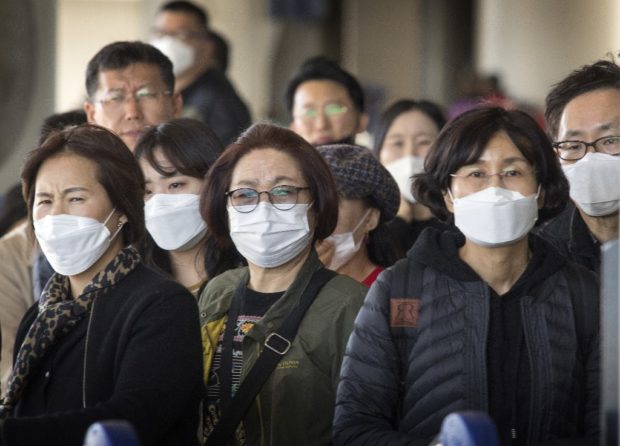
Passengers wear face masks to protect against the spread of the Coronavirus as they arrive on a flight from Asia at Los Angeles International Airport, California, on January 29, 2020. (AFP)
BEIJING–The death toll from the new coronavirus outbreak has surged to 2,000, as Chinese and international health officials warned against excessive measures to contain the epidemic.
More than 74,000 people have now been infected by the virus in China, with hundreds more cases in some 25 countries.
The situation remains serious at the epicenter, with the director of a hospital in the central city of Wuhan becoming the seventh medical worker to succumb to the COVID-19 illness.
But Chinese officials released a study showing most patients have mild cases of the infection, and World Health Organization officials said the mortality rate was relatively low.
The outbreak is threatening to put a dent in the global economy, with China paralyzed by vast quarantine measures and major firms such as iPhone maker Apple and mining giant BHP warning it could damage bottom lines.
Several countries have banned travellers from China and major airlines have suspended flights — something that Beijing’s ambassador to the EU warned was fuelling panic and threatening attempts to resume business.
Russia on Tuesday said no Chinese citizens would be allowed to enter its territory from February 20.
The Philippines has imposed a temporary travel ban covering visitors coming from mainland China, Hong Kong, Macau, and has just lifted its ban to Taiwan. It also bars Filipinos from traveling to these territories in a bid to contain the spread of COVID-19.
Philippine Health Undersecretary Eric Domingo explained only Filipinos and holders of permanent Philippine resident visas coming from these places will be allowed to enter the Philippines subject to a mandatory quarantine.
Local airline executives also admitted their operations have been affected with passengers seeking refunds or rebooking trips overseas after Philippine Airlines (PAL), Cebu Pacific Air and Air Asia Philippines gave passengers the option to rebook or refund tickets to China until next month.
For instance, Cebu Pacific, which serves over 20 million passengers annually, has 55,000 seats per week allocated to China routes such as Beijing, Shanghai, Canton, Xiamen, Shenzen, Hong Kong and Macau.
PAL, on the other hand, flies to Beijing, Shanghai, Canton, Xiamen, Jinjiang, Hong Kong and Macau while Air Asia Philippines has flights to Canton, Shanghai, and Shenzen, Hong Kong and Macau.
The epidemic has triggered panic-buying in Singapore and Hong Kong, concerns about cruise-ship travel and the postponement of trade fairs, sports competitions and cultural events in China and abroad.
Authorities have placed about 56 million people in hard-hit central Hubei and its capital Wuhan under an unprecedented lockdown.
The city was carrying out “very good public health practice” with door-to-door surveillance, said Michael Ryan, head of WHO’s health emergencies program.
Other cities far from the epicenter have restricted the movement of residents, with a 14-day self-quarantine for people returning to Beijing.
President Xi Jinping, in a phone call with British Prime Minister Boris Johnson, said China’s measures were achieving “visible progress”, according to state media.
‘Less deadly’ than SARS
The official death toll in China hit 2,000 after another 132 people died in Hubei, where the virus emerged in December.
Liu Zhiming, the director of Wuchang Hospital in Wuhan, became its latest victim, sparking an outpouring of grief online.
The much-publicized death of Dr. Li Wenliang last February 7, 2020 created a media storm when he tried to warn the world about the coronavirus outbreak in late December 2019 in Wuhan.
Days before his death while being treated for the deadly virus, Li said the situation could have been different had the Chinese officials acted immediately instead of censoring him and hiding the information from the public.
In the beginning of the crisis it seemed that the Chinese National Government put its own interests above the lives and safety of the Chinese People and the world.
“If the officials had disclosed information about the epidemic earlier,” he told the New York Times, “I think it would have been a lot better. There should be more openness and transparency.”
Official figures, meanwhile, showed there were nearly 1,700 new COVID-19 cases on Wednesday in Hubei.
New infections have been falling in the rest of the country for the past two weeks.
WHO chief Tedros Adhanom Ghebreyesus cautioned that it was too early to tell if the decline would continue.
A study among tens of thousands of confirmed and suspected cases showed that 81 percent of patients had only mild infections.
The study released by China’s Centre for Disease Control and Prevention also showed the death rate stood at 2.3 percent, falling below one percent for people in their 30s and 40s.
WHO officials said the COVID-19 illness was “less deadly” than its cousins, such as Severe Acute Respiratory Syndrome (SARS) or Middle East Respiratory Syndrome (MERS).
But it is higher than the mortality rate for the seasonal flu, at around 0.1 percent in the United States.
Ryan said the outbreak was “very serious” and could grow, but stressed that outside Hubei the epidemic was “affecting a very, very tiny, tiny proportion of people”.
There have been some 900 cases around the world, with five deaths in France, Japan, the Philippines, Taiwan and Hong Kong.
Another 88 people tested positive for the virus on the quarantined Diamond Prince cruise ship off Yokohama in Japan, raising the number of those infections to 542.
The US has repatriated more than 300 American passengers and Britain became the latest country to offer its citizens a way off the ship after similar plans by Canada, Australia, Hong Kong and South Korea.
And around 500 passengers were to leave the vessel on Wednesday after testing negative for the virus.